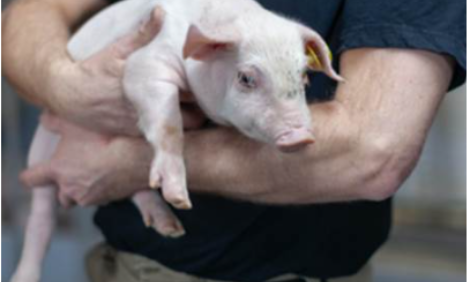



Focus on Feed Efficiency in Pork Production
Feed represents the largest proportion of cost of production, contributing up to 70 per cent of the variable cost of production. This is nothing new, writes Ken Engele, Manager of Information Services at the Prairie Swine Centre.
In the past couple of
years, we have seen feed costs rise to historically
high levels. Costs may retreat somewhat but it
is highly unlikely in the short term that we will see
feed costs dip to levels experienced in 2004 and
2005.
There has always been emphasis on feed
efficiency in production systems, however, the
discussion comes to the forefront when feed costs
rise and show no real signs of a significant retreat.
Since feed costs represent the largest portion of
cost of production, it also represents the greatest
opportunity for reducing costs in particular the
grower-finisher barn. Feed efficiency can have the
single biggest impact on feed cost per pig. With
the higher feed costs, there has been a greater
push towards managing feed efficiency within
operations. At current feed costs, an improvement
in feed efficiency of 0.1kg of feed per kg of gain
will result in a greater than C$2.00 net income per
pig marketed.
There are a number of considerations that
need to be taken into account when examining
feed efficiency in pork production: environmental (temperature, humidity, air
circulation), social (space allocation, group size, re-grouping), immunological (disease, pathogen
concentration) and management (particle size,
feeder adjustment).
Factors Impacting Feed Efficiency
- Genetics: Are you feeding according to the
maximum lean yield potential of your herd?
- Feed processing: Understanding the impact
of pelleting and size of grind. Industry
standard for particle size is 600 to 800 microns.
Kansas State University demonstrated a 1.2 per cent
improvement in feed efficiency for every 100–micron reduction in particle size relative to
the optimal range. Pigs fed pelleted diets versus
mash have three to six per cent better feed efficiency.
- Management: Ensure feeders are checked
daily and feeders are adjusted for 40 per cent pan
coverage to maximise feed efficiency, by
maximising performance and minimising feed
wastage. In addition, a three per cent reduction in pen
space translates to a one per cent reduction in feed
intake and growth rate.
- Dietary energy level: Use of alternative feed
ingredients typically provides a lower energy
density within the diet, thereby increasing the
amount of feed required per pig. Pigs will
typically compensate for the lower energy
diets by increasing their consumption,
subsequently having a significant impact on
feed efficiency. Poorer feed efficiency may be
offset by cheaper diet cost. It is very important
to monitor this relationship.
- Environmental temperature: Ensure pigs are
kept within their thermal comfort zone. Cold
temperatures increase feed intake while hot
temperatures reduce feed intake.
- Disease challenge: Healthy pigs grow faster.
Pigs are able to utilise nutrients for growth
rather than fight disease. Disease challenges
can also increase mortality, when occurring in the finishing herd can have significant impact
on whole herd efficiency.
- Breeding herd productivity: On average, a
sow will consume approximately one tonne
of feed per year. The greater number of pigs
produced per sow will improve whole herd
feed efficiency.
- Market weight: Feed efficiency worsens as pigs get heavier. Ensure pigs are marketed at their optimal weight to minimise feed cost per kg gain, maximizing profit potential.
While this is not an inclusive list of factors
that influence feed efficiency, it gives us the
perspective of the multi-disciplinary approach that
is required to achieve its full potential. One of the
ways in which Prairie Swine Centre is delivering
this message is through a series of webinars
specifically dedicated to a ‘Focus on Feed
Efficiency’.
This series of eight Feed Efficiency webinars
are being delivered in partnership with the
Farm Leadership Council starting on 5 March and
concluding on 19 June. Webinars will run on two–week intervals by well-known experts in the area
of feed efficiency discussing a wide range of topics
including: feeding and barn management, whole
herd factors, feed processing, new technologies
and health impact on feed efficiency.
| "Focus on Feed Efficiency" Webinar Series | ||
|---|---|---|
| March 5, 2012 (1:30 p.m.) | The Future of Precision Livestock Farming | Dr. Candido Pomar, Agriculture and Agri-Food Canada |
| March 27, 2012 (1:30 p.m.) | Feeding and Barn Management Practices that Maximize Feed Efficiency | Dr. Bob Goodband, Kansas State University |
| April 10, 2012 (1:30 p.m.) | Herd Management Factors that Influence Whole Herd Feed Efficiency | Dr. Aaron Gaines, The Machoffs |
| April 24, 2012 (1:30 p.m.) | New Processing Technologies that may Influence Feed Efficiency | Dr. Tom Scott, University of Saskatchewan |
| May 8, 2012 (10:30 a.m.) | Health Effect on Feed Efficiency | Dr. Steve Dritz, Kansas State University |
| May 22, 2012 (10:30 a.m.) | Fueling the Immune response: What is the Cost? | Dr. Rod Johnson, University of Illinois |
| June 5, 2012 (10:30 a.m.) | Emerging Technologies with Potential to Influence Feed Efficiency | Dr. Denise Beaulieu, Prairie Swine Centre |
| June 19, 2012 (10:30 a.m.) | Dietary Energy Concentration and Feed Efficiency Targets: What are the right questions, and do we have the answers | Dr. John Patience, Iowa State University |
April 2012








